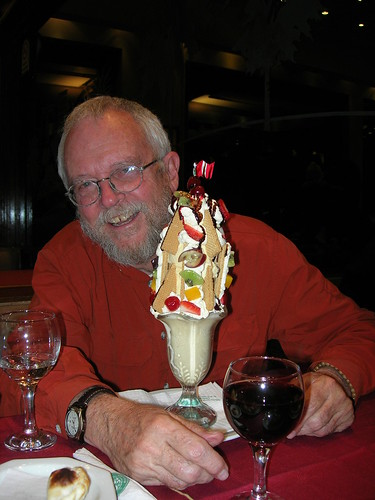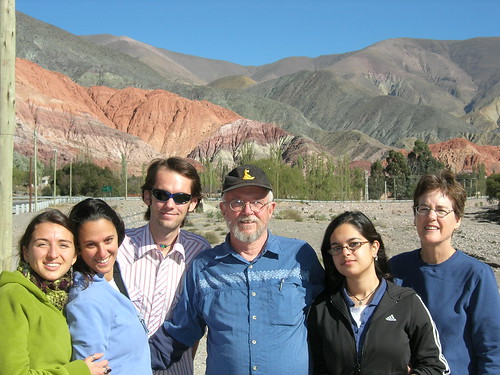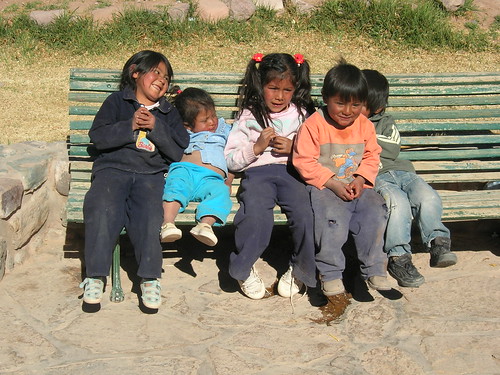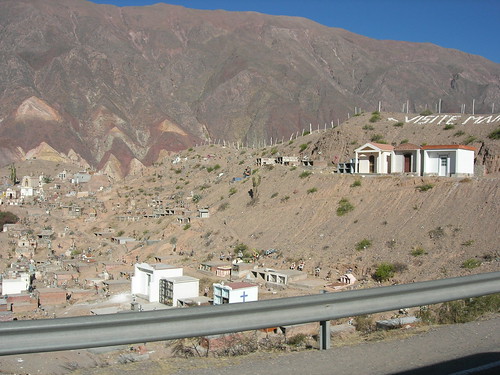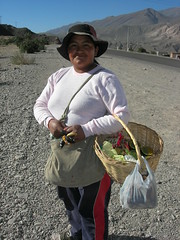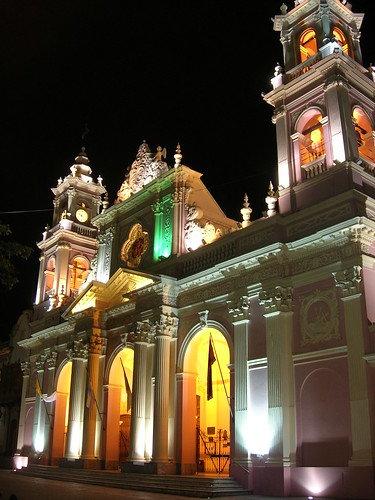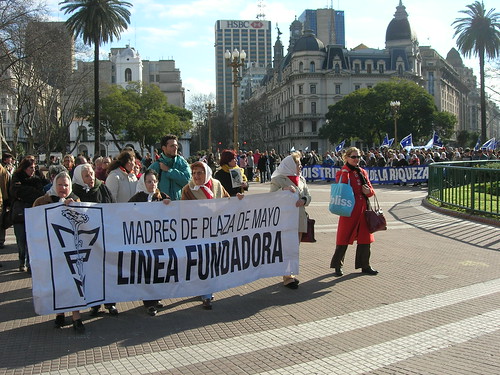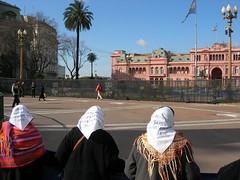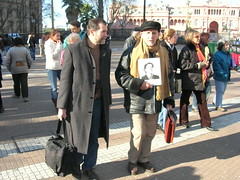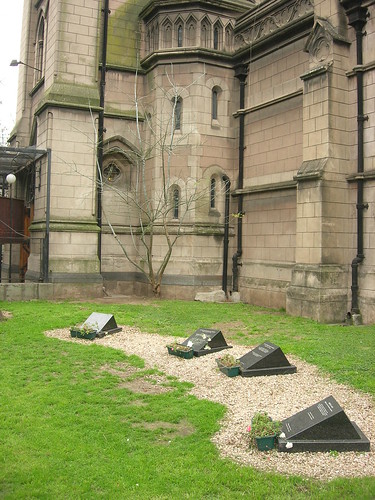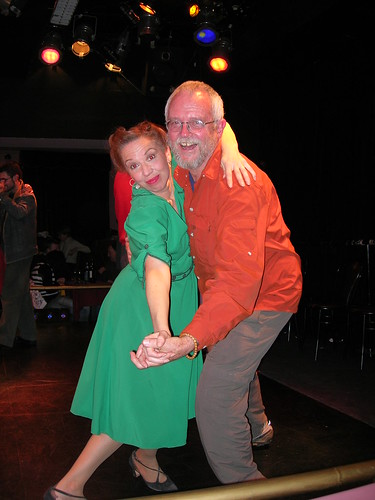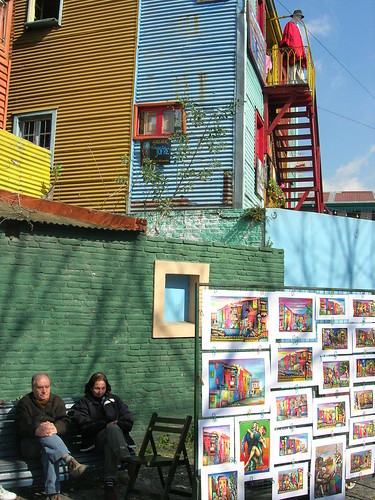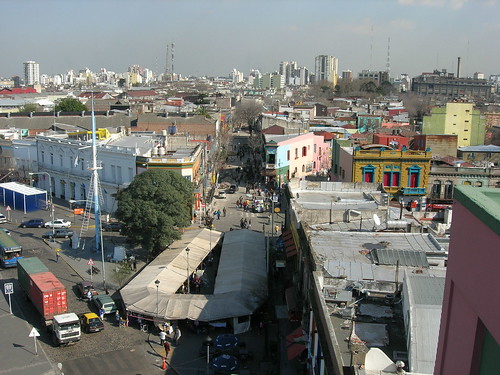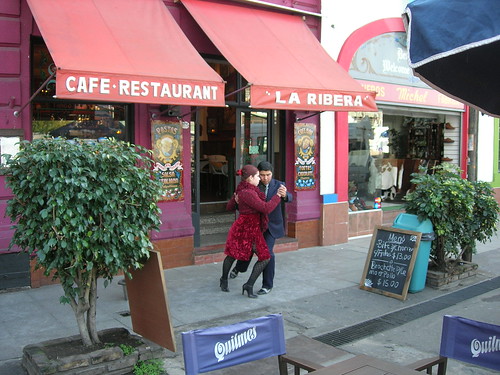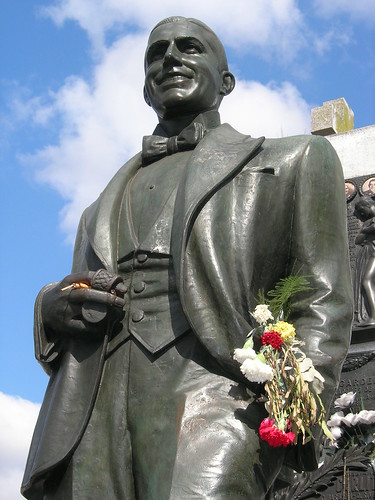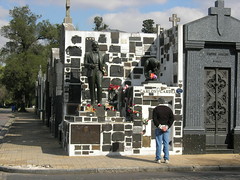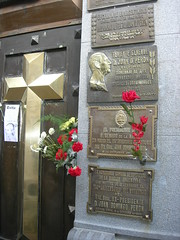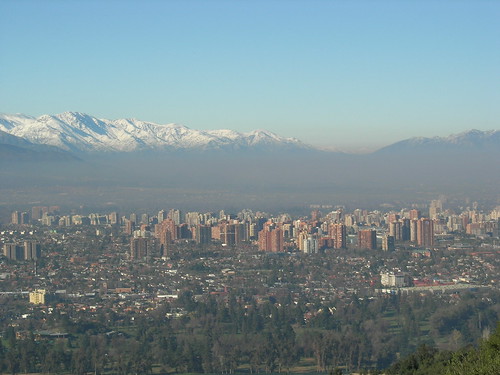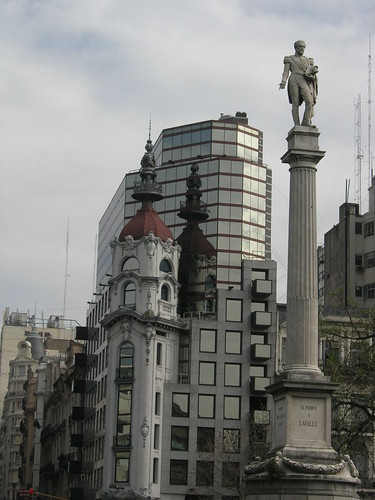
It's time to take stock of my experience in Argentina. I have been in Buenos Aires now almost four weeks and our plane leaves in tomorrow for California and home. Yesterday morning when we met in a cafe in Palermo to study for this afternoon's final exam, Toni brought with her a tourist guide she had found in her host's apartment. It was written for people like us who have come to Argentina to study Spanish. And it told of the three-week syndrome when visitors become sick of Buenos Aires, Argentina and their Spanish classes. But it passes quickly, according to the guide. Not so for Toni who by Wednesday was so sick of everything about this place that she was ready to fly off to Tierra del Fuego and Antarctica. She wanted nothing to do with the farewell banquet to be held tonight at a nice restaurant in Las Cañitas.
I don't want to speak for Toni, who has her own reasons to be fed up with being here. But the negativity among the students is palpable and it does not at all resemble the experience I had studying Spanish in Oaxaca a year and a half ago. I don't partake much in the gossip but I do hear that many in our group from Cabrillo are discontented. One reason might be sickness. A large number seem to be hacking and wheezing and one is able to manage only by taking codeine-laced cough syrup which she bought by canvassing numerous farmacias until she found one willing to sell her the drug. There are complaints about living arrangements, the lack of hot water, absence of privacy, the difficulty of finding a place to study, weak light bulbs, poor food (or no food). Several students have given up on classes altogether because they were more interested in exploring the city than memorizing verb tenses. Others find the material covered too demanding (or the progress too rapid), and some find their fellow students a distraction.
I have been told that I'm a success, that my happiness with the Argentine experience is rare. Certainly I don't embrace the negativity I've heard (being prone to make lemonade. But I am not a polyanna about this city and country and have some critical to say about it. On my part, I think I'm lucky. Ofelia has been a wonderful hostess,and although living together in such a confined space has not been easy, I have managed to get my major needs met: a good shower, adequate and tasty food, and a comfortable bed which has made sleep easy. I don't spend much time in Ofelia's third-floor aparment on Avenida Santa Fe in Palermo, but stay out daily from 9 in the morning until about 9 at night. Certainly this way, we don't get tired of each other.
I came well prepared to have a good time. For months I've been watching films made in Argentina, reading the Lonely Planet Argentina guide and two LP guides for Buenos Aires, reading a history of the country by Jonathan C. Brown, and listening to tango music, particularly the classic songs by Carlos Gardel. I watched again Madonna's "Evita" as well as a documentary on Mrs. Peron's life and a fictional version made by an Argentine director. I was familiar with the "Dirty War" and its consequences and I was particularly eager to march in the Plaza de Mayo with the mothers of the disappeared who have been in search of justice for almost thirty years.
Exploring new cities has become somewhat of an obsession with me. I've been to Bangkok several times and can find my way around it easily. Last summer I went to Barcelona for a week to study Gaudi's architecture and practice my Spanish. I followed this with Rome, and spent much time in London which I knew well from my days there circa 1964-66. In Vietnam last fall I walked all over Saigon and Hanoi. Antigua, Guatemala, may be much smaller, but I know its streets and churches well, as I do the sights in Oaxaca. So I knew what to do when I came to Buenos Aires and I had plenty of time to do it in. On our cathedral tour in England last summer, one of the members talked of "bagging" another church. I've just bagged another city.
Rather than recount every experience that I've checked off in my Lonely Planet guides, I want to make some general observations about the people I've met and observed here and draw some conclusions about the culture. When I met with Beverly Keene yesterday, an America who has spent twenty years here, she confirmed many of my impressions.
The Subte (underground or metro) is old and in need of some sprucing up, but it's efficient, and I have taken the D line numerous times from Carranza station in Palermo to the Catedral station in the Microcentro barrio downtown. Most of the time I've stood because the cars always seem full and I've looked closely at the people. The ride is frequently interrupted by beggars and entertainers. The other day a young man began talking loudly while holding up a picture of a cat. Then another man at the end of the car began shouting at him. They had a loud dialogue back in forth in Spanish which I could not understand and I tried not to look. Then the people in the car applauded, and I realized it had all been street (or Subte) theater, although I don't have a clue what it was about. Then the actors passed the hat. I've seen children with babies, jugglers, vendors of useless goods, a reggae singer, and more. It's often entertainer and never uninteresting.
My impression, however, is that the people I see are sad and lifeless. Their mostly European faces often have a gray unhealthy palor. Of course, visiting a city in winter is not the best time to make judgements about what its like all year round. But I can't help thinking that the long ugly war against its own people, and the endless economic trouble has crushed the spirit of Argentians. It doesn't hold true of everyone I've met. Eugenia, our wonderful teacher, is a live wire, full of curiosity and enthusiasm. The daughter of two doctors, she is obviously from a privileged class and has been well educated. The young people I see in the lounge at the Universidad de Belgrano are like young people everywhere. But the homeless I see sleeping or drinking in the parks (not unlike Santa Cruz or San Francisco), and the poor cartoneros who come into the city at night to pick up recyclable paper and cardboard show another side. Many of the poor I see have dark skin and are probably immigrants from Peru, Bolivia and Paraguy, and some are probably here illegally. Eugenia confirms that there is racism against people with indigenous genes and dark skin.
One of the high points of my trip was going to midnight mass on the eve of the feast day of San Cayetano. I heard about him at the Museo de Deuda Externa, where images of the saint are used to illustrate unemployment. He has become the patron saint of bread and jobs here in Argentina and his feast day, Augusut 7, is a major occasion. It turned out that Ofelia was a devotee of this saint and she took me, along with her tenant Rita, to the mass not far off Avenido Cabildo in Belgrano. It was not the major shrine, which is out of the city in Lineares, but there were hundreds of people at nearly midnight who were lined up waiting to be the first to pray at the statue of the saint and touch him for good luck. The hall was packed and we had good seats since we arrived early. The pilgrims streamed by the saint on the mezzanine upstairs endlessly during the long mass. At the end, people held up stalks of wheat, symbolizing bread, and the keys to their house to be blessed by the priest. It was for me a moving experience of popular piety in action. I think Jesus would be proud.
Another high point of my trip, two actually, was the discovery of two wonderful artists. Eugenia had mentioned Antonio Berni in class as an artist who painted social justice themes and I saw a wonderful painting of his at the Malba gallery of a strike in the 1930s with a sign in the background reading "Pan y Trabajo." The huge painting contained a sea of poor faces and was heart-rending. The other artist whose works I first saw at the Malba was Xul Solar. He has been called the William Blake of Argentina (I think the multi-talented Berni is probably the Pablo Picasso), and I later went to visit the mseum at his house and was awed by what I saw. His work is colorful and playful and his themes constantly refer to an eccentric spirituality that I love.
Walking in the Plaza de Mayo with two groups of mothers of the disappeared was very moving and certainly a high point, as was talking with three of them at their office about what it was like to lose a daughter or son and not know what happened, then or now. I enjoyed talking with Juan De Wandelear about his work putting together a memorial to all the victims of state violence which will resemble the Vietnam wall. He told me about a memorial to four women that had been disappeared in the 1970s from the Iglesia de Santa Cruz and I went to pay a visit. I was surprised at how many demonstrations I saw of people disgruntled about something. Porteños do not seem as apathetic as my countrymen, many of whom are anesthetized by too much wealth, or by the media, to the wrongs of the world.
I loved sitting in the many cafes drinking cappuchino or caffe con leche or cafe costado and reading, doing homework or watching the people, and the very efficient waiters in their white coats. I liked that they always delivered along with the coffee a glass of water, with gas or without, and often a tiny cookie.
I've already spoken at length in my blog about the two weekend trips I took -- to Santiago, Chile, and to Salta and the Quebrada de Humahuaca in the northwest of Argentina. Both were illuminating experiences and they gave me very different perspectives on the southern cone of South America.
There is so much more positive that I could say, but I want to add a few more words of criticism. Buenos Aires is full of dogs and dog-walking is a major career choice (I saw walkers with up to 20 dogs at a time). But dogs need to poop and the sidewalks are filled with caca, even though there are laws like our own which require people to pick up afterwards. Stepping in Argentine dog shit is a memorable experience one would like to forget. The sidewalks are often dangerous for many reasons, not the least because the pavement is often uneven and broke, and the ground litered with trash. The residents seem to think nothing of droping cigarette butts, papers, and what we would think of as recyclable cans and bottles on the ground. I understand that Buenos Aires has a nighly garbage pickup but you wouldn´t know it from walking in their filthy streets. Ofelia agreed with me that it was a tragedy.
It's not that porteños are obsessed with death, but I have appreciated the ornate homes for the dead they've constructed in the cemeteries in Recoleta Chacarita. I visited Evita's tomb in the first and Peron's in the second and it's unclear why they're not buried closer together but rather reside for eternity across town from each other. It might have been the doing of Peron's second wife, Isabel. Both tombs are quite modest but the faithful bring flowers to each daily. I also visited Carlos Gardel's grave in Chacarita where the walls are littered with plaques thanking him for his music and favors rendered. I watched a man cross himself as if Gardel has already been beatified. There is a life-sized statue of him and devotees place lit cigarettes between his fingers. Another pilgrimage was to Gardel's house in Abastos, the district where he lived. The house is modest but a number of the buildings on the street have been colorfully painted with fileta decorations, the unique porteño style of baroque lettering. There are images of Gardel everywhere in Bs As and he stands alongside Evita as the icons of Argentina (Che Guevara who was born here comes a close third).
I haven't said anything about the Obelisco which looks like the Washington Monument, or about mate drinking or the fair in Matadores on the outskirts of the city that we attended the first weekend, or the limited national cuisine unless you love steaks and pizza. Also on that first weekend was a glorious sunny Saturday when the whole city seemed to congregate in the Bosques of Palermo, a lovely where where I went bicycle riding. Or watching Stravinsky's three ballet operas at the magnificent Teatro Colon which is about to celebrate its 100th anniversary. Clearly there is much to see and do in this city.
Finally, I want to say something about studying Spanish in Buenos Aires. It hasn't been easy, but I think that has something to do with the leaky nature of my aging brain. Although I studied at length, I'm sure I did a very poor job on the final yesterday. Not for lack of help from Eugenia, our teacher, however. She has been wonderful, and the conversations she's stimulated in class have gone all over the map: abortion, Argentina's politics, Noam Chomsky and various linguists, movies, whether we're optimists or pessimists (Argentinans, we learned, think little of the future but live primarily for today; they are obsessed with appearance). Rather than teach to the text, Eugenia took cues from our mistakes and our questions to guide us through the intracies of verb tenses and the difference between por and para. It didn't seem like we progressed through that much material in the four weeks we studied with her, but I know that I'll carry some of her lessons and insights with me back to California. For a party gift I bought her today a Spanish translation of Thomas Merton's writings on oriental religions.
Last night Moochie invited me to dinner with her guests, Lorraine and Toni, and Nancy, our teacher from Cabrillo, also came. Michael, Moochie's other guest from Texas, also joined us for a terrific dinner of gourmet pizzas, ensalada a la casa, and a fine Malbec wine which was my contribution (it's impossible to pay more than $10 for a bottle, no matter how good it is). Moochie gave me an interesting magazine on the martyrdom of Bishop Enrique Angelelli and the gesture touched me. She is a former nun and understands my interest in monasticism and Thomas Merton. I wish I understood her Spanish better. She speaks rapidly and has an accent I believe which sounds a little different from what I hear around me. After desert (lemon cream pie and some sort of dulce), I tendered my adios and went home across the street.
And so, after another farewell dinner tonight, and a farewell lunch planned for me by Ofelia on Saturday, I bid Bs As and Argentina adios and hasta luego. The news about air travel, however, is not good. Because of the arrest in London of two dozen people plotting to blow up U.S.-bound airplanes with bombs inside liquid in carryon luggage, all liquids now are banned and luggage is being examined more closely. There will probably be long delays tomorrow. My first suspicion was that it was another group of men who were overheard complaining about the U.S. and thinking of terrible things they might do to it. But apparently, the plot was much more sophisticated and advanced. So therefore I'm thankful they've been captured. But it will impact our trip home and might affect plans for travel to India in December.

 Besides the small group of her closest friends, Molly's parents were special guests. I haven't seen all that much of her mother, Cici, in the five years that we have been divorced, and sharing the honor of celebrating the birth of our daughter felt a bit awkward. But the focus on Molly filled the empty spaces and there was much laughter as we rehearsed how we would greet them when Tibi brought Molly into the house. Finally the car lights shone in the driveway and we hunkered down in dark silence as footsteps came down the hall.
Besides the small group of her closest friends, Molly's parents were special guests. I haven't seen all that much of her mother, Cici, in the five years that we have been divorced, and sharing the honor of celebrating the birth of our daughter felt a bit awkward. But the focus on Molly filled the empty spaces and there was much laughter as we rehearsed how we would greet them when Tibi brought Molly into the house. Finally the car lights shone in the driveway and we hunkered down in dark silence as footsteps came down the hall.  I gave Molly my small present first, a copy of Sharon Salzberg's book, Loving-Kindness: the Revolutionary Art of Happiness. Several years ago, I had given her the Buddhist teacher's book Faith and Molly said that she was finally reading it and appreciating Salzberg's insights. I thought the classic book on loving kindness meditation was a suitable followup.
I gave Molly my small present first, a copy of Sharon Salzberg's book, Loving-Kindness: the Revolutionary Art of Happiness. Several years ago, I had given her the Buddhist teacher's book Faith and Molly said that she was finally reading it and appreciating Salzberg's insights. I thought the classic book on loving kindness meditation was a suitable followup.

